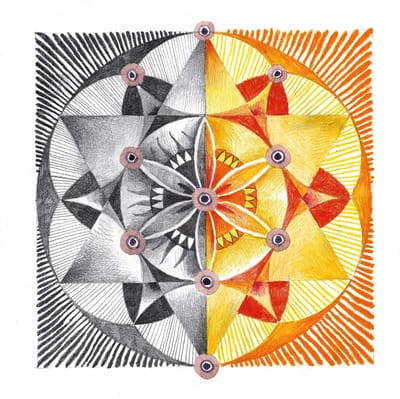Kabbalah and Mandalas
The language of the Kabbalah corresponds to the
symbolic language of the Mandala (the Sanskrit word for “circle”). The Mandala is
a creative attempt to express the search for the image of God that exists within
all human beings.
The drawing of the mandala begins from the inner point known as Bindu (a Sanskrit word meaning “point” or “dot”), which corresponds to the Hebrew letter yod in the language of the Kabbalah. The mandala develops and expands from the Bindu, which is the point from which godliness flows into the material world.
The drawing of the Mandala and study of the Kabbalah are different ways to connect to the Self (the godly part of human beings). “Come and see: There is no circle in the world that is not created from a single point that exists in the center. This point that stands in the center takes all the light and illuminates the body, and all is illuminated.”
The wisdom of the Mandala and the wisdom of the Kabbalah attempt to describe the infrastructure of Creation using models and symbols. For example, the Star of David, a six-pointed symbol, describes the link between heaven and earth. In Jewish mysticism, the Star of David parallels the six points associated with the six Sefirot from Hesed to Yesod. The Star of David is superimposed upon the model of the Seed of Life Mandala, which also has six points and represents the creation of the universe.
The wisdom of the Kabbalah and the wisdom of the Mandala describe, each in its own way, the creation of the world from an invisible point — the Bindu, which parallels the Sefirah of Hokhmah, and the spark of being shining from the Void. Then comes expansion from the point to the circle, which parallels the Sefirah of Binah. The circle resembles empty space and the divine womb from which the world can come into being. The next stage is the line or triangle that describes the direction of development and the drawing of divine light into the empty space. In the language of geometry, the line and the triangle parallel the Sefirah of Tiferet, which symbolizes balance. The next stage of development is the square, which describes earthly, reality, which is stable and safe. The square also represents the Sefirah of Malkhut. The four-pointed structure parallels the Tetragrammaton, which is made up of four letters. The process comes to completion with the square, which Kabbalistic wisdom describes as a process of coming into being from the infinite to the finite. It is here that our task as human beings begins: to elevate ourselves from the finite back to the infinite.
The drawing of the mandala begins from the inner point known as Bindu (a Sanskrit word meaning “point” or “dot”), which corresponds to the Hebrew letter yod in the language of the Kabbalah. The mandala develops and expands from the Bindu, which is the point from which godliness flows into the material world.
The drawing of the Mandala and study of the Kabbalah are different ways to connect to the Self (the godly part of human beings). “Come and see: There is no circle in the world that is not created from a single point that exists in the center. This point that stands in the center takes all the light and illuminates the body, and all is illuminated.”
The wisdom of the Mandala and the wisdom of the Kabbalah attempt to describe the infrastructure of Creation using models and symbols. For example, the Star of David, a six-pointed symbol, describes the link between heaven and earth. In Jewish mysticism, the Star of David parallels the six points associated with the six Sefirot from Hesed to Yesod. The Star of David is superimposed upon the model of the Seed of Life Mandala, which also has six points and represents the creation of the universe.
The wisdom of the Kabbalah and the wisdom of the Mandala describe, each in its own way, the creation of the world from an invisible point — the Bindu, which parallels the Sefirah of Hokhmah, and the spark of being shining from the Void. Then comes expansion from the point to the circle, which parallels the Sefirah of Binah. The circle resembles empty space and the divine womb from which the world can come into being. The next stage is the line or triangle that describes the direction of development and the drawing of divine light into the empty space. In the language of geometry, the line and the triangle parallel the Sefirah of Tiferet, which symbolizes balance. The next stage of development is the square, which describes earthly, reality, which is stable and safe. The square also represents the Sefirah of Malkhut. The four-pointed structure parallels the Tetragrammaton, which is made up of four letters. The process comes to completion with the square, which Kabbalistic wisdom describes as a process of coming into being from the infinite to the finite. It is here that our task as human beings begins: to elevate ourselves from the finite back to the infinite.
